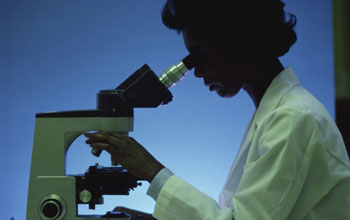News Release 11-117
Social Scientists Study Impact of Human Adult Stem Cell Research
Researchers say human pluripotent stem cells and embryonic stem cell research is complementary

Analysis of some 2,000 papers shows any disruption of stem cell research could harm the field.
June 9, 2011
This material is available primarily for archival purposes. Telephone numbers or other contact information may be out of date; please see current contact information at media contacts.
New research says studying both reprogrammed adult cells and embryonic stem cells can benefit medical science, but banning the study of embryonic stem cell research could harm studies of reprogrammed adult cells.
Researchers from the University of Michigan, Stanford University and the Mayo Clinic in Rochester, Minn. recently investigated whether the increased number of studies with induced pluripotent stem (iPS) cells--adult cells that have been coaxed into an "embryo-like" state--has changed the overall course of research in the field.
The researchers analyzed more than 2,000 scientific papers and found reprogrammed adult cells are not replacing human embryonic stems cells in the laboratory. Instead, the two cell types have proven to be complementary and any disruption of federal funding, they say, would negatively impact stem cell research overall.
"This is an important study that systematically examines the coauthorship networks of stem cell research articles and uses those to understand the interactions between two complementary areas of research," says Julia Lane, program director for Science of Science & Innovation Policy at the National Science Foundation, which funded the study. "It is particularly interesting because it uses new analytical techniques to advance our understanding of how the implementation of policy in one area can affect scientific research in another area."
The research appears in the June 9 journal Cell.
"The incentives to use both types of cell in comparative studies are high," says Jason Owen-Smith, a sociologist at University of Michigan. He notes the science behind adult tissue that can be "reprogrammed," to produce human induced pluripotent stem cells is still in its infancy, having become widely available in 2007.
"As a result, induced pluripotent stem cells do not offer an easy solution to the difficult ethical questions surrounding embryonic stem cell research," he says.
Pluripotent stem cells are those capable of differentiating into any type of tissue, hence the attractiveness of embryonic stem cells, or hESCs, also called ES cells, which are also pluripotent.
The researchers examined stem cell research papers published between 1998 and 2010. They found the proportion of papers using reprogrammed adult and embryonic stem cells together is growing faster than those using reprogrammed cells alone.
In 2008, only 15 or 5.1 percent of all papers examined in the study reported using reprogrammed adult cells, and only three of those papers combined the use of reprogrammed adult cells and embryonic stem cells. By 2010, some 161 of 574 or 28 percent of papers reported on studies of both cell technologies, and 62.1 percent of those papers paired induced and embryonic stem cell lines.
Because use of the two cell types has become so intertwined, any federal policy that would deny funding for embryonic stem cell research "would derail work with a nascent and exciting technology," says Owen-Smith.
If federal funding stops for human embryonic stem cell research, it would have a serious negative impact on reprogrammed adult cell research, says Stanford University bioethicist Christopher Scott, one of the paper's co-authors. "We may never be able to choose between iPS and ES cell research because we don't know which type of cell will be best for eventual therapies."
"The whole point with science policy is to have a more scientific basis to understand the impacts of policy decisions on science if and when those decisions are made," says Lane.
In addition to the National Science Foundation, this research was funded by grants from the National Institutes of Health and the Stanford Institute for Stem Cell Biology and Regenerative Medicine.
-NSF-
Media Contacts
Bobbie Mixon, NSF, (703) 292-8485, email: bmixon@nsf.gov
Jim Erickson, University of Michigan, (734) 647-1842, email: ericksn@umich.edu
Program Contacts
Julia I. Lane, NSF, (703) 292-5145, email: jlane@nsf.gov
Principal Investigators
Jason Owen-Smith, University of Michigan, (734) 936-0700, email: jdos@umich.edu
Co-Investigators
Christopher Thomas Scott, Stanford University, (650) 725-6103, email: cscott@stanford.edu
The U.S. National Science Foundation propels the nation forward by advancing fundamental research in all fields of science and engineering. NSF supports research and people by providing facilities, instruments and funding to support their ingenuity and sustain the U.S. as a global leader in research and innovation. With a fiscal year 2023 budget of $9.5 billion, NSF funds reach all 50 states through grants to nearly 2,000 colleges, universities and institutions. Each year, NSF receives more than 40,000 competitive proposals and makes about 11,000 new awards. Those awards include support for cooperative research with industry, Arctic and Antarctic research and operations, and U.S. participation in international scientific efforts.
Connect with us online
NSF website: nsf.gov
NSF News: nsf.gov/news
For News Media: nsf.gov/news/newsroom
Statistics: nsf.gov/statistics/
Awards database: nsf.gov/awardsearch/
Follow us on social
Twitter: twitter.com/NSF
Facebook: facebook.com/US.NSF
Instagram: instagram.com/nsfgov


